Your baby’s pediatrician might check for early signs of Citrullinemia Type 1 (CIT), also known as CTLN1, during routine check-ups. If any signs are present, prompt treatment may be recommended.
A newborn screening test is crucial for early detection of various conditions, including Citrullinemia Type 1. If your baby’s newborn screening result for CIT was outside the normal range, you will be contacted for further testing. It’s vital to understand that an out-of-range screening result doesn’t automatically confirm your baby has CTLN1. Such results can occur due to factors like a small initial blood sample or early testing. However, because some newborns do have this condition, immediate follow-up is essential. Attending your follow-up appointment for a confirmatory test is critical to determine definitively if your baby has Citrullinemia Type 1. Untreated CTLN1 can have harmful effects shortly after birth, making timely follow-up testing absolutely necessary to ascertain your baby’s health status regarding this condition.
Confirmatory testing typically involves analyzing your baby’s urine and blood samples to detect abnormal levels of acids and toxins. In conditions like Citrullinemia Type 1, specific acids and toxins accumulate in the body. Measuring these substances helps doctors diagnose CTLN1. Elevated levels of ammonia and citrulline in the blood, along with orotic acid in the urine, may indicate the presence of CTLN1. In some cases, a small skin sample might also be tested as part of the follow-up diagnostic process.
